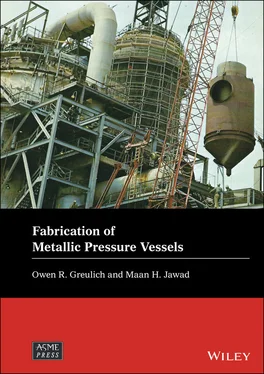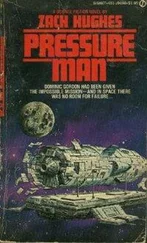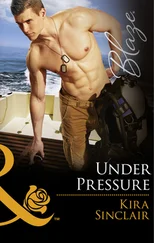Maan H. Jawad - Fabrication of Metallic Pressure Vessels
Здесь есть возможность читать онлайн «Maan H. Jawad - Fabrication of Metallic Pressure Vessels» — ознакомительный отрывок электронной книги совершенно бесплатно, а после прочтения отрывка купить полную версию. В некоторых случаях можно слушать аудио, скачать через торрент в формате fb2 и присутствует краткое содержание. Жанр: unrecognised, на английском языке. Описание произведения, (предисловие) а так же отзывы посетителей доступны на портале библиотеки ЛибКат.
- Название:Fabrication of Metallic Pressure Vessels
- Автор:
- Жанр:
- Год:неизвестен
- ISBN:нет данных
- Рейтинг книги:4 / 5. Голосов: 1
-
Избранное:Добавить в избранное
- Отзывы:
-
Ваша оценка:
- 80
- 1
- 2
- 3
- 4
- 5
Fabrication of Metallic Pressure Vessels: краткое содержание, описание и аннотация
Предлагаем к чтению аннотацию, описание, краткое содержание или предисловие (зависит от того, что написал сам автор книги «Fabrication of Metallic Pressure Vessels»). Если вы не нашли необходимую информацию о книге — напишите в комментариях, мы постараемся отыскать её.
A comprehensive guide to processes and topics in pressure vessel fabrication Fabrication of Metallic Pressure Vessels
Fabrication of Metallic Pressure Vessels
Fabrication of Metallic Pressure Vessels — читать онлайн ознакомительный отрывок
Ниже представлен текст книги, разбитый по страницам. Система сохранения места последней прочитанной страницы, позволяет с удобством читать онлайн бесплатно книгу «Fabrication of Metallic Pressure Vessels», без необходимости каждый раз заново искать на чём Вы остановились. Поставьте закладку, и сможете в любой момент перейти на страницу, на которой закончили чтение.
Интервал:
Закладка:
1.3.2.8 Forming
Vessel fabricators will usually use one of four ways of making vessel shells.
First, as noted in Section 1.3.2.3.3, the least expensive way of producing a vessel shell is almost always to purchase a standard size of pipe, if it is available. This is usually true even for rolled and welded pipe.
Second, if large quantities are to be produced, is to develop dies and form shell sections using a large press. The cost of this tooling, even ignoring the cost of a press large enough to perform this type of work, is high, and it will only be justified by large quantities of product. For large quantities, however, this approach allows the production of shell sections (usually halves or thirds) with a single stroke of a press. Even the cost of installing the dies may be fairly high, and may not be cost effective for single vessels.
Third, rolled shell sections may be produced using forming rolls as described in Section 4.3, followed by placement of longitudinal welds. This technique is especially useful for diameters and shell lengths that can be rolled out of a single piece, since it efficiently produces cylinders requiring only a single longitudinal weld.
Finally, shells can be produced on a press brake. This is usually more labor intensive than either forming rolls or forming dies, but for small quantities of shell courses or if control of all aspects of the production is needed, it can make sense. For a company possessing a press brake but not forming rolls, rolling of pressure vessel shells can be accomplished in either of two ways: first, the shell can be “bump rolled” on the press, usually in sections, and second, the company can either buy the finished product or send shell material to a fabricator possessing a set of rolls for rolling. If the first approach is taken, the labor cost for bump‐rolling itself is probably greater than that for a product produced using forming rolls, but the cost of extra layout, pre‐crimping or cutting off extra material allowed in place of crimping (thicker sections), and shipping the product both directions are eliminated. Thus, for a single product, bump‐rolling may be adopted, while the second approach is likely if a number of shells are required and the roll setup costs can be better distributed over the number of shells produced.
If a very large quantity of the product is to be produced, particularly if it is to be produced on an ongoing basis, then a company may invest in a set of forming rolls. The cost of the rolls is then amortized over the life of the product line, costs go down, and the company has a new capability.
1.3.2.9 Fixturing
As in the case of tooling for rolling a shell course, the value of fixturing for fit‐up and assembly is often limited for production of a single or low volume product, but as production rises the cost of fixturing may remain constant while the benefits increase.
For a single shell, tack‐welded lugs, wedges, and clamps are often all that are needed and used for alignment, though in some cases hydraulic rams may be used. Lugs will be flame cut out of stock plate and welded in place – number of lugs, thickness of lugs, and amount of weld vary depending on how much “persuasion” the fit up is anticipated to require. After pushing shell edges (for example) into alignment so that they can be tacked together for welding, the wedges are removed, the lugs are ground free or knocked off, and any damage to the plate surface is repaired and ground flush.
Compare this scenario to the shop that has many shells of either the same size or a small number of predictable sizes to be produced. In this case, design and construction of fixtures to accomplish the same thing can cut individual shell fit‐up time significantly. Once shell fit‐up fixtures are constructed, the following might take place: The rolled plate section is placed on the fixture. Portions of the fixture will be swung into place and pinned. Hydraulic rams will push the sides and ends of the shell to bring the longitudinal joint into rough alignment. Other rams are used to bring the edges into the same plane. The side rams may be further adjusted to provide the proper root opening. The longitudinal seam is tacked, the rams are released, the fixture arms are moved back to provide space to remove the shell course, and the next shell is brought in.
There is often a sizable investment in a fixture such as this, and any such equipment that is developed will occupy shop space, so it shouldn’t be done without consideration of the returns. However, this investment can cut what may be an 8–16 (or even more) hour job to a matter of an hour or so.
1.3.2.10 Welding
A similar situation arises in the case of manual versus automated welding. A number of different processes may be used to produce welds. Each has its benefits and drawbacks. Chapter 7discusses welding in detail and provides a comparison of various welding processes, including deposition rates. Items to consider include equipment and setup costs versus the benefits of more efficient placement of welds, design for production runs rather than individual fabrications, and weld configurations, such as narrow welds to minimize weld metal required and residual stresses.
1.3.2.11 Hydrotesting
Pressure testing is most often performed using water or other comparably incompressible fluids. Hydrotest of a single vessel is usually accomplished by filling it, pumping to pressure, holding, and draining the vessel. For single vessels, the water is usually dumped after use, and pumping is accomplished using a small positive displacement pump.
If the quantity of vessels produced in accordance with a particular vessel design is such that multiple vessels are tested daily, then it is common to set up test fixtures and to salvage and recycle the water. As with other means employed to reduce per unit cost, the savings must be weighed against the up‐front cost of fixturing, constructing a reservoir, etc.
1.3.3 Shipping
For most pressure vessels, the cost of shipping is not more than a few percent of the total cost, yet even that is enough that it should be considered in the price of the product. For products that are extremely large or extremely heavy, however, that percentage may increase.
The size and load capacity of standard rail cars facilitate shipment of many vessels that might require permits as wide, long, or heavy loads if shipped by truck. Rail rates (per pound) are often much less than truck rates. Barges even more so, if the size of the product justifies them. This is especially the case if permits or special routing are needed for trucking. Rail shipments often take longer than trucks, however, due to the way that rail traffic is routed.
In any case, unless the estimator is confident of knowing shipping costs with a good degree of accuracy, it would be good to verify costs with shippers prior to bidding a job. See Chapter 11for more information regarding shipping.
1.3.4 General approach to cost control
Effective management of cost involves making trades based on actual costs of the delivered product. It therefore requires assessment not only of material and labor costs but also the cost of shipping. This will be especially important for shipment of large and/or heavy fabrications. These are likely to require permits and may require special equipment and routing, raising costs far above the usual cost per pound for shipping.
A general rule, with some exceptions, is that labor costs outweigh material costs and that labor is therefore the area most ripe for cost reductions.
If, for example, material represents 10% of the cost of a product, then any reduction in material costs must clearly be less than 10% of the cost of the overall product. This could be the case for a carbon steel vessel with complex fit‐up. For this, vessel reductions in labor likely do not increase material costs significantly and should be considered as ways of reducing overall costs.
Читать дальшеИнтервал:
Закладка:
Похожие книги на «Fabrication of Metallic Pressure Vessels»
Представляем Вашему вниманию похожие книги на «Fabrication of Metallic Pressure Vessels» списком для выбора. Мы отобрали схожую по названию и смыслу литературу в надежде предоставить читателям больше вариантов отыскать новые, интересные, ещё непрочитанные произведения.
Обсуждение, отзывы о книге «Fabrication of Metallic Pressure Vessels» и просто собственные мнения читателей. Оставьте ваши комментарии, напишите, что Вы думаете о произведении, его смысле или главных героях. Укажите что конкретно понравилось, а что нет, и почему Вы так считаете.











